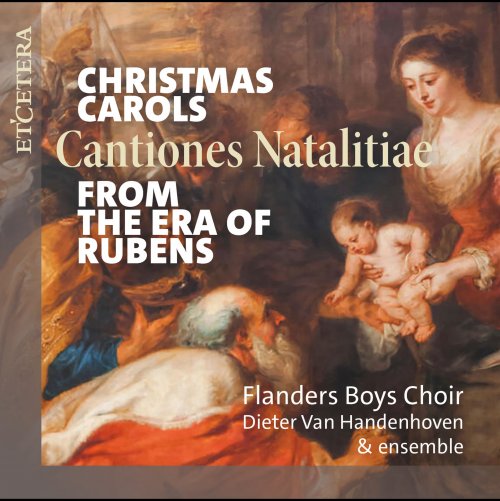
Flanders Boys Choir, Dieter van Handenhoven & ensemble - Christmas Carols from the Era of Rubens - Cantiones Natalitiae (2023)
BAND/ARTIST: Flanders Boys Choir, Dieter van Handenhoven & ensemble
- Title: Christmas Carols from the Era of Rubens - Cantiones Natalitiae
- Year Of Release: 2023
- Label: Etcetera
- Genre: Classical
- Quality: flac lossless (tracks)
- Total Time: 01:00:44
- Total Size: 337 mb
- WebSite: Album Preview
Tracklist
01. Nu Coridon 't Is Tijdt
02. Pijp Op, Pijp Op met Blij Gheschal
03. Ballet De L'archiducq Leopolde
04. O Quam Amabilis Es Bone Iesu
05. Ras Herders Nacht Ghesellekens
06. Symphonia 6 A 3
07. Terwijl 't Gheheele Lant
08. Aria - Sarabande - Ballo 3 - Ballo 1
09. Maene, Sterren, Nachtplaneten
10. Nato Deo Gloria Solemnis
11. Herderkens en Herderinnekens van Bethlem
12. Aria Flegmatica - Corante - Agricola Chorea
13. Wel Hoe Wie Light Daer Soo
14. Sonata Sexta a 3
15. Herderkens met Uwe Fluyt
16. Wilt U Al Verblijden
In the musical history of the Southern Netherlands during the seventeenth century, Christmas music was a genre in its own right. This is mainly thanks to the Brotherhood of Our Lady of the Antwerp Cathedral, where, around 1600, the custom arose of lighting up the daily Mary prayers during the Christmas period not only with Marian motets, but also with carols. As early as 1604, this repertoire appeared in print, titled Laudes Vespertinae. Its contents consisted mainly of Marian hymns, complemented by Latin carols. With later reprints in 1629 and 1648, the proportion of Christmas music grew systematically, which was also increasingly written in the vernacular.
This evolution led the music publisher Phalesius to print separate publications with carols, titled Cantiones Natalitiae, from the mid-1640s onwards. Until the end of the 17th century, around 16 of these volumes were published, first compilations of works by several composers, and later publications dedicated to a single composer. This was accompanied by a stylistic evolution: while the earliest works were still in a homophonic Renaissance style, from the middle of the century a new generation of composers emerged who embraced the new Baroque style, with solo voices accompanied by basso continuo, and participation of solo instruments.
01. Nu Coridon 't Is Tijdt
02. Pijp Op, Pijp Op met Blij Gheschal
03. Ballet De L'archiducq Leopolde
04. O Quam Amabilis Es Bone Iesu
05. Ras Herders Nacht Ghesellekens
06. Symphonia 6 A 3
07. Terwijl 't Gheheele Lant
08. Aria - Sarabande - Ballo 3 - Ballo 1
09. Maene, Sterren, Nachtplaneten
10. Nato Deo Gloria Solemnis
11. Herderkens en Herderinnekens van Bethlem
12. Aria Flegmatica - Corante - Agricola Chorea
13. Wel Hoe Wie Light Daer Soo
14. Sonata Sexta a 3
15. Herderkens met Uwe Fluyt
16. Wilt U Al Verblijden
In the musical history of the Southern Netherlands during the seventeenth century, Christmas music was a genre in its own right. This is mainly thanks to the Brotherhood of Our Lady of the Antwerp Cathedral, where, around 1600, the custom arose of lighting up the daily Mary prayers during the Christmas period not only with Marian motets, but also with carols. As early as 1604, this repertoire appeared in print, titled Laudes Vespertinae. Its contents consisted mainly of Marian hymns, complemented by Latin carols. With later reprints in 1629 and 1648, the proportion of Christmas music grew systematically, which was also increasingly written in the vernacular.
This evolution led the music publisher Phalesius to print separate publications with carols, titled Cantiones Natalitiae, from the mid-1640s onwards. Until the end of the 17th century, around 16 of these volumes were published, first compilations of works by several composers, and later publications dedicated to a single composer. This was accompanied by a stylistic evolution: while the earliest works were still in a homophonic Renaissance style, from the middle of the century a new generation of composers emerged who embraced the new Baroque style, with solo voices accompanied by basso continuo, and participation of solo instruments.
Year 2023 | Classical | XMAS & Holiday | FLAC / APE
As a ISRA.CLOUD's PREMIUM member you will have the following benefits:
- Unlimited high speed downloads
- Download directly without waiting time
- Unlimited parallel downloads
- Support for download accelerators
- No advertising
- Resume broken downloads


